Top 12 Alternatives Sales Navigator That Crush Quotas in 2025

I’ll be blunt: for years, my team and I were chained to LinkedIn Sales Navigator. We paid the premium, dutifully ran our searches, and celebrated the occasional win. But over time, the signal got lost in the noise. The data felt stale, the outreach felt generic, and the ROI was no longer adding up. Does that sound familiar?
I started wondering if we were just paying for the brand name. That frustration sparked a deep dive into the world of sales intelligence tools. I was seeking powerful alternatives Sales Navigator that could deliver more accurate data, better integration, and a genuine competitive edge. Spoiler alert: I found them. 🚀
This is my personal playbook, built from weeks of hands-on testing, feature comparison, and discovering what actually works for generating high-quality B2B leads. I'm sharing everything I learned, the wins, the mistakes, and the "aha!" moments, so you can skip the trial-and-error and find the perfect platform for your specific sales motion.
In this article, you'll find in-depth, honest reviews of tools like GojiberryAI, Apollo.io, ZoomInfo, and more. Each profile includes a clear breakdown of who it's for (and who should avoid it). Let’s find the tool that will transform your pipeline.
1. GojiberryAI: The AI-Powered Lead Whisperer
When you're grinding to build a pipeline, the last thing you want is to spend hours sifting through LinkedIn, only to find leads as cold as ice. We've all been there, right? You build a massive list, launch a campaign, and get… crickets. 🦗
It's a classic mistake, focusing on who your ICP is, but forgetting to ask when they are ready to buy. GojiberryAI is engineered to solve this exact problem, making it one of the most powerful alternatives to Sales Navigator for teams that prioritize timing and intent.
Instead of just providing a static list, GojiberryAI functions as a radar for real-time buying signals across LinkedIn. It's not about scraping data; it's about intelligent monitoring. The platform alerts you when a prospect changes jobs, engages with a competitor's post, or when their company gets a fresh round of funding.
These are the golden moments to reach out, and this tool puts them right at your fingertips.
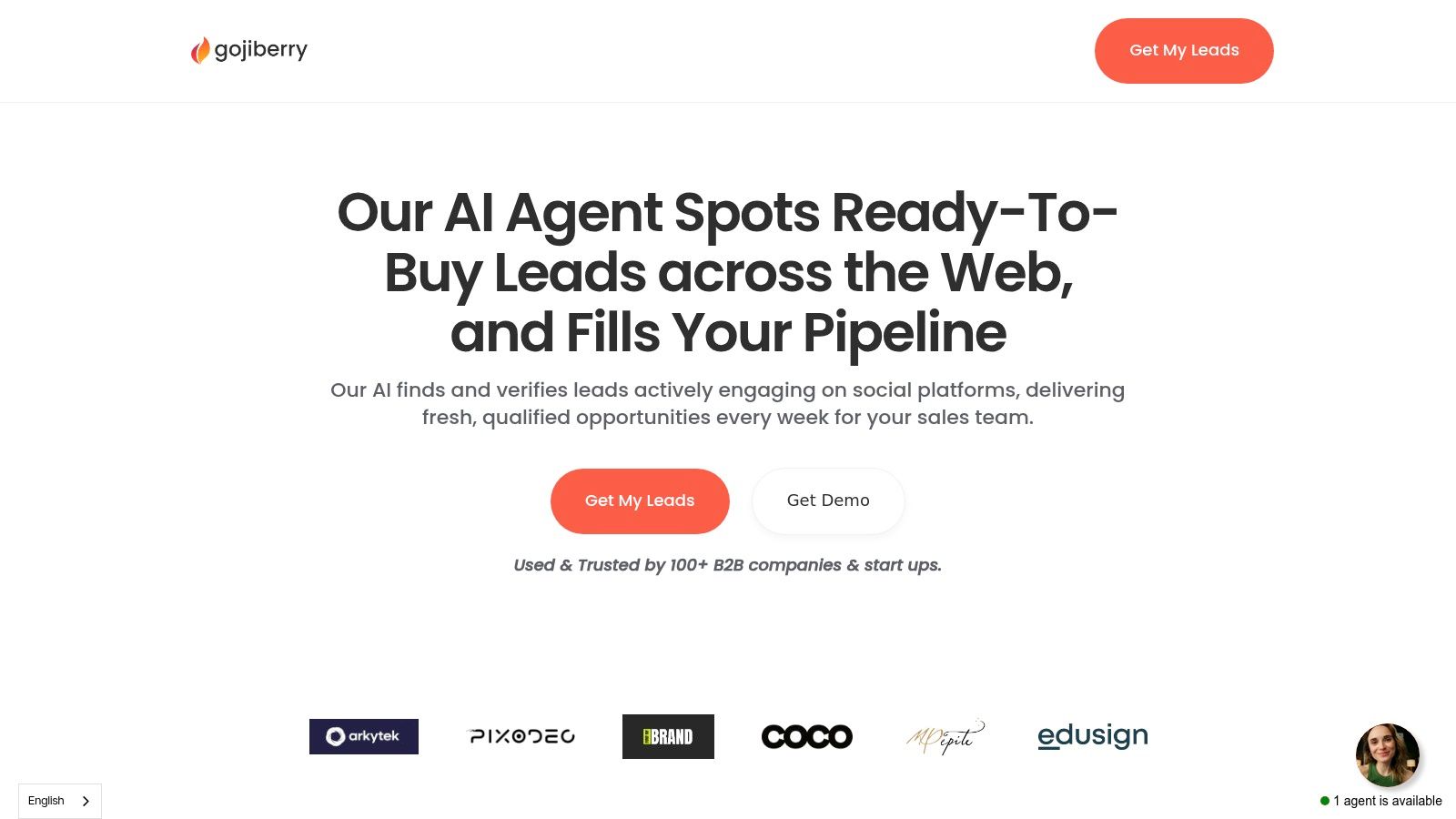
Why It Stands Out
What makes GojiberryAI a featured choice is its laser focus on actionable intent. While Sales Navigator helps you find people, GojiberryAI helps you find people at the right time. It automates the painful part of prospecting - identifying warm leads - and delivers them directly into your workflow.
For example, imagine you sell HR software. A key trigger for you is a company hiring a Head of People. Instead of manually searching for this, you can set up a trigger in GojiberryAI.
The moment it happens, you receive a notification with the new hire's verified contact details, which are pushed directly to your Slack and CRM. This is how 73% of their users book a meeting in their first week. It’s a game-changer.
Key Takeaway: GojiberryAI transforms your outreach from 'hoping for the best' to a strategic, event-driven process with a much higher chance of success. It’s about being the first to knock on the door when a new window of opportunity opens.
Key Features and Use Cases
- Real-Time Buying Signal Tracking: Monitors LinkedIn for high-intent activities, such as job changes, funding announcements, and competitor engagement.
- Automated Lead Delivery: Feeds enriched, verified leads directly into your CRM or outreach tools like Instantly and Lemlist.
- Workflow Integration: Seamlessly connects with your existing sales stack, saving your team over 10 hours a week on manual prospecting.
Practical Tip: Don't just track your direct competitors. Set up alerts for companies that solve adjacent problems. If a lead follows or engages with them, they're likely in a buying mindset for your entire category.
Website: https://gojiberry.ai
Pros
Cons
Identifies high-intent leads based on real-time LinkedIn activity.
Primarily focused on LinkedIn data, it may not capture signals from other platforms.
Seamlessly automates workflows with native CRM and outreach tool integrations.
Pricing is not public; requires a direct inquiry, which might be a hurdle for smaller teams.
Proven to significantly boost campaign reply rates and shorten the time to the first meeting.
A Sales Navigator account is often necessary to fully utilize the platform.
Trusted by over 100 B2B companies with strong testimonials on immediate ROI.
2. Apollo.io
Apollo.io positions itself as a powerful all-in-one prospecting platform, making it a compelling alternative to Sales Navigator, especially for teams looking to consolidate their tech stack. Think of it as combining a massive B2B contact database with a full-fledged sales engagement platform.
This means you can find your prospects, enrich their data, and reach out to them via email sequences and a built-in dialer, all without leaving the Apollo ecosystem. It’s a game-changer for SMBs and mid-market companies that need robust functionality without the enterprise-level price tag.
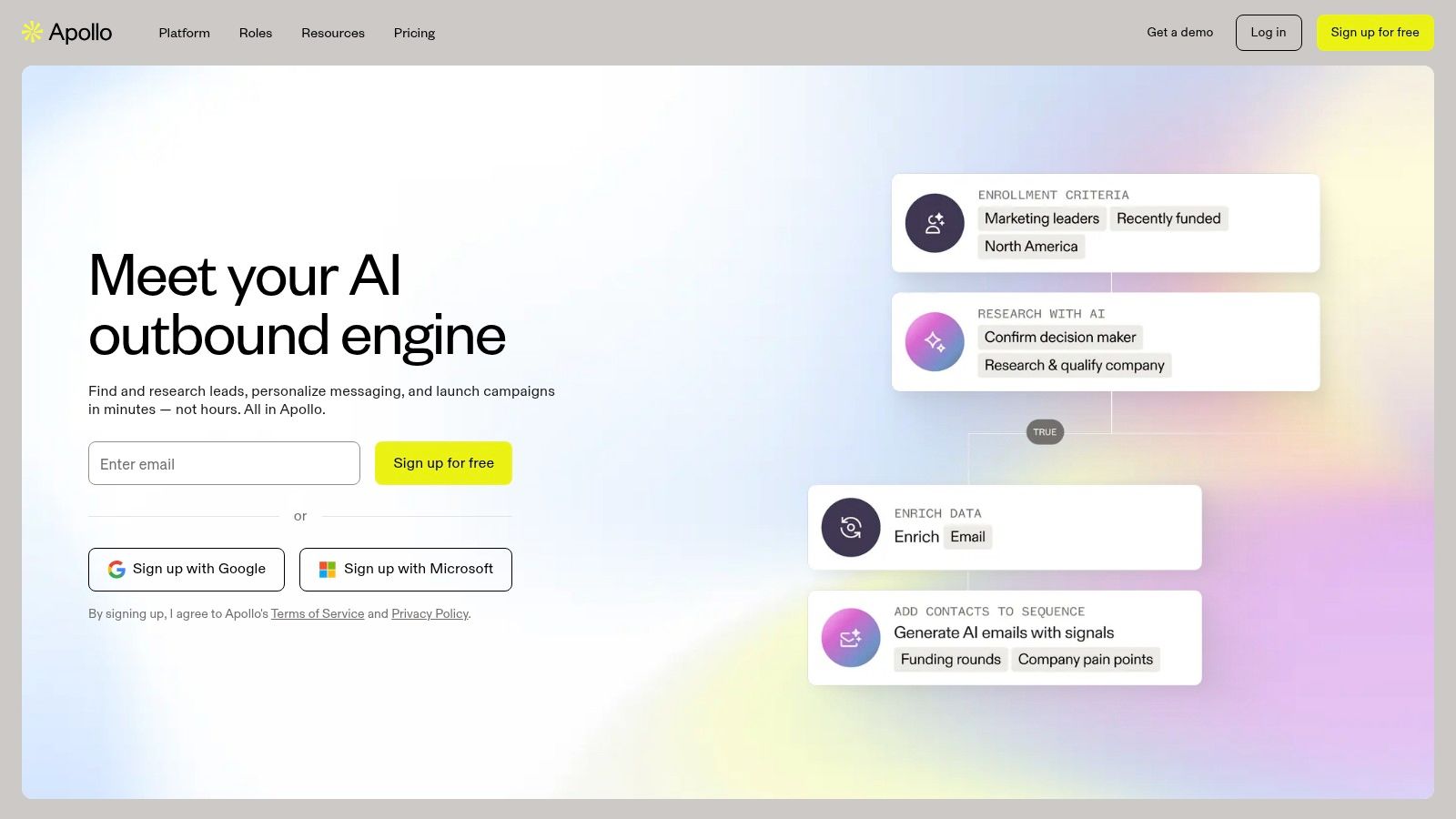
What really sets Apollo apart is its value proposition. You gain access to a massive database of over 250 million contacts, along with the tools to effectively engage them. We found their Chrome extension to be incredibly useful for extracting verified emails directly from LinkedIn profiles, which significantly streamlined our initial outreach process.
While it's a powerful tool, it's worth noting that its strength lies in being a jack-of-all-trades. If you're looking for different capabilities or a more specialized approach, you can explore other alternatives to Apollo.io to find the perfect fit for you.
Key Features & User Experience
- Integrated Outreach: Native email sequences and a dialer with call recording ensure your entire top-of-funnel workflow is centralized in one place.
- Transparent Pricing: Apollo offers a generous free tier and clear, self-serve paid plans. This is a breath of fresh air compared to the opaque pricing of other platforms.
- Buying Intent Data: On higher tiers, you can identify companies actively researching solutions like yours, enabling more targeted outreach.
- Broad Integrations: It syncs seamlessly with major CRMs, such as Salesforce and HubSpot, as well as engagement tools like Outreach and Salesloft.
Pros & Cons
- Pro: The all-in-one nature provides fantastic value, especially for smaller teams on a budget.
- Con: Credit limits can be somewhat challenging to manage across tiers, and purchasing add-on credits requires careful planning to avoid workflow interruptions. We also noticed some occasional variance in data accuracy when pulling contacts at a very high volume.
3. ZoomInfo SalesOS
ZoomInfo SalesOS is the heavyweight champion in the sales intelligence arena. This makes it a formidable alternative to Sales Navigator for enterprise teams that demand deep, actionable data. It's less of a simple contact database and more of a complete Go-To-Market intelligence engine.
For large sales organizations, particularly in the US, ZoomInfo offers an extensive depth of company and contact information. This includes detailed organizational charts, technographics (the type of tech they use), and powerful buying intent signals. If your strategy relies on identifying companies actively in-market for your solution, ZoomInfo is hard to beat.
What truly defines ZoomInfo is its enterprise focus. This isn't just a tool; it's a platform designed to be the central data hub for your entire revenue team. During our evaluation, the web visitor identification feature was particularly impressive, as it unmasked anonymous website traffic and converted it into qualified leads.
While its power is undeniable, it comes at a significant cost and complexity. If you're a smaller team or find the enterprise commitment daunting, exploring some alternatives to ZoomInfo might reveal a more suitable fit for your specific needs.
Key Features & User Experience
- Advanced Firmographics & Technographics: Uncover deep insights into a company’s structure, revenue, and the technology stack they use.
- Intent Data & Scoops: Identify "in-market" accounts based on online research behavior and receive alerts on key company events, such as funding rounds or leadership changes.
- Robust Integrations: Seamlessly connects with major CRMs and marketing automation platforms to enrich your existing data and power workflows.
- Web Visitor De-anonymization: The "FormComplete" feature can identify anonymous visitors to your site, providing you with leads you may not have been aware of.
Pros & Cons
- Pro: The sheer breadth and accuracy of its US-centric data, combined with advanced intent signals, provide a significant competitive advantage.
- Con: The platform comes with a high price tag, often requiring multi-year contracts and opaque enterprise pricing, making it inaccessible for many SMBs.
4. Lusha
Lusha is all about speed and simplicity, making it a fantastic Sales Navigator alternative for sales reps who live in their browser. It operates primarily through a slick Chrome extension that overlays on LinkedIn profiles and company websites. With a single click, you can reveal verified B2B contact details.
We found it very efficient for quick prospecting; you simply take the data you need from where you found the prospect, without using a complicated platform. It’s perfect for individual reps or small teams that need quick, accurate contact information without the commitment of a full-funnel platform.
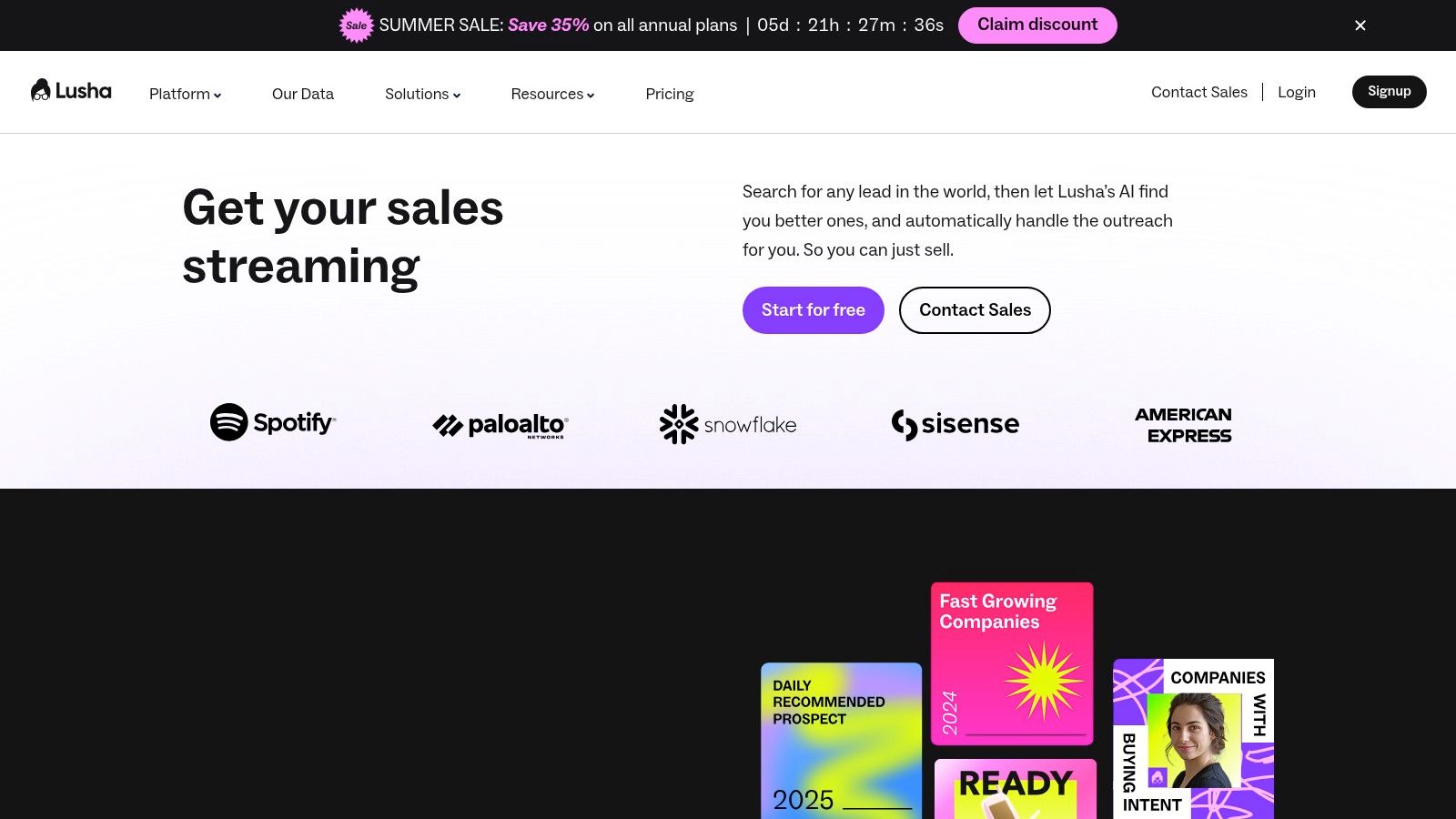
The magic of Lusha is its credit-based system. You get a monthly allowance of credits to “spend” on revealing contact information. This model provides great flexibility, starting with a free plan that’s genuinely useful for low-volume users.
The user experience is dead simple; the extension just works. However, its focus is purely on data enrichment. If you require advanced filtering, list building, or integrated outreach tools, you'll need to pair Lusha with another solution or consider other alternative sales navigator options in this article.
Key Features & User Experience
- Powerful Chrome Extension: The product enables you to access contact information with a single click on LinkedIn and business websites.
- Credit-Based Model: Pay only for the data you need. The system is transparent, with a free tier offering monthly credits to get you started.
- High Data Accuracy: Lusha emphasizes its data verification process, resulting in reliable direct dials and emails.
- Simple CRM Integration: Easily syncs revealed contacts and their data to platforms like HubSpot, Salesforce, and Pipedrive to streamline workflows.
Pros & Cons
- Pro: Extremely easy to deploy and use, with virtually no learning curve. The flexible credit system is great for scaling up or down as needed.
- Con: The cost per reveal for phone numbers can add up quickly for teams doing heavy cold calling. Data coverage can also be inconsistent depending on the specific industry or geographical region you're targeting.
5. Cognism
Cognism is a standout Sales Navigator alternative for teams where data compliance and verified phone numbers are non-negotiable. It’s built on a foundation of GDPR and CCPA compliance. This makes it a go-to choice for companies operating in heavily regulated industries or those with a strong focus on the EMEA market.
Their secret weapon? Human-verified mobile numbers. This significantly increases connection rates for sales teams that rely heavily on phone outreach, bypassing gatekeepers directly to decision-makers. It’s less of an all-in-one engagement tool and more of a premium, high-accuracy data provider.

What really caught our attention with Cognism was its commitment to quality over sheer quantity. While its database might not be the largest, the accuracy of its mobile data, especially in Europe, is top-tier. Their Chrome Extension is fantastic for enriching profiles directly from LinkedIn or company websites, and the platform seamlessly pushes this verified data into your CRM.
It’s an investment, but for teams struggling with low-quality phone data, the ROI is clear. If you want to dive deeper into building a pipeline with this kind of quality data, you can learn more about these powerful B2B lead generation strategies.
Key Features & User Experience
- Diamond Data®: This feature provides human-verified mobile numbers and emails, ensuring an extremely high accuracy rate for direct dials.
- Compliance-First Approach: Cognism screens against Do-Not-Call lists and provides a clear audit trail, giving legal and ops teams peace of mind.
- Global Coverage: Although its roots are in the EMEA region, the platform boasts strong and continuously growing coverage in North America and the APAC region.
- Intent & Enrichment: Integrates with leading intent data providers and offers robust data enrichment to keep your CRM records fresh and accurate.
Pros & Cons
- Pro: Unmatched data accuracy for mobile numbers and a strong compliance framework, which is crucial for global outreach. The hands-on onboarding is a huge plus.
- Con: The premium nature comes with a higher price point, and pricing is only available via a custom quote. It’s best suited for teams where verified phone data is a primary GTM channel; otherwise, the cost may be hard to justify.
6. UpLead
UpLead stakes its claim as a top-tier Sales Navigator alternative by focusing obsessively on one thing: data accuracy. For sales teams that have been burned by bounced emails and wrong numbers, UpLead offers a breath of fresh air.
It offers a clean, straightforward B2B prospecting database with a powerful promise of 95% data accuracy, backed by real-time email verification. This means you’re not just pulling a list; you’re confirming each contact's validity right before you use a credit.
It's an ideal choice for SMBs and lean teams who need reliable contact info, especially mobile numbers, without the complexity or cost of an enterprise suite.
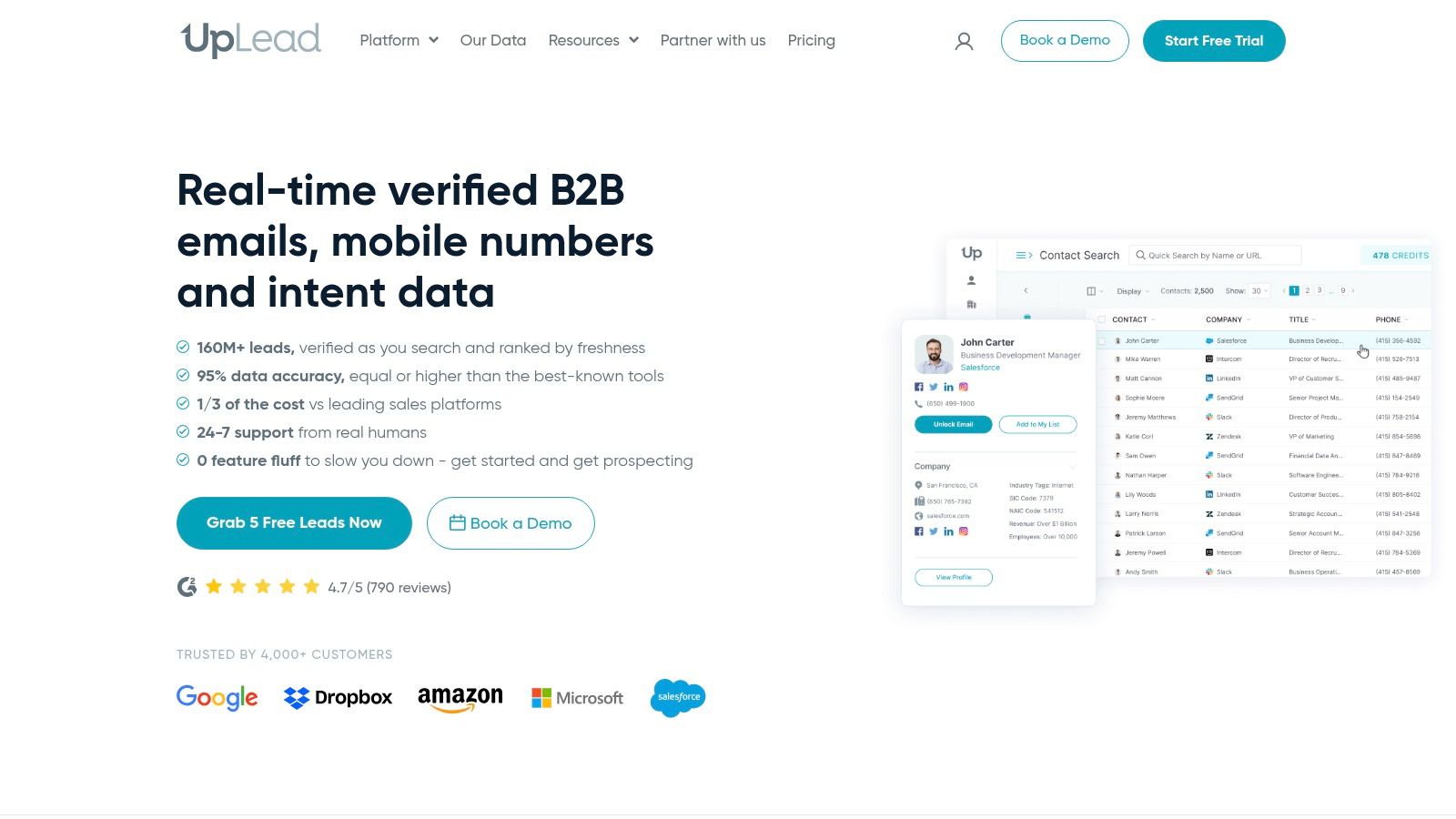
What we really appreciated during our testing was the simplicity and transparency of the platform. There are no hidden modules or complex add-ons. You get a powerful search interface, technographic data, and, on higher plans, buyer intent signals.
Their Chrome extension is also great for grabbing verified data directly from company websites or LinkedIn profiles. This straightforward approach makes it a fantastic, no-nonsense alternative for teams that prioritize accuracy and efficiency over having a million different features they'll never use.
Key Features & User Experience
- Real-Time Verification: Its standout feature. You can verify emails in real-time, ensuring your credits are only spent on high-quality, deliverable contacts.
- Technographics: Filter companies based on the specific technologies they use (e.g., find all companies using HubSpot CRM), making your targeting laser-focused.
- Simple UI: The user interface is incredibly intuitive. You can build lists and export them to your CRM or sales engagement tool in minutes.
- Generous Trial: UpLead offers a free trial with credits, allowing you to fully test the data quality before committing to a paid plan.
Pros & Cons
- Pro: The 95% accuracy guarantee, combined with real-time verification, provides incredible confidence in your outreach data. The pricing is transparent and credit-based.
- Con: Monthly credit limits on lower tiers can feel restrictive for high-volume outbound teams. It’s also a more pure-play data provider, lacking the built-in engagement tools of all-in-one platforms.
7. RocketReach
RocketReach stands out as a straightforward and highly accessible contact database, making it a solid alternative to Sales Navigator for those who prioritize speed and ease of use. It's popular with individual reps, recruiters, and small teams who need to find verified emails quickly without using a complicated, large-scale platform.
The core value here is simplicity. You can sign up, install the Chrome extension, and start pulling contact information from social profiles or company websites in minutes. It's a no-fuss tool for getting the direct contact data you need, right when you need it.
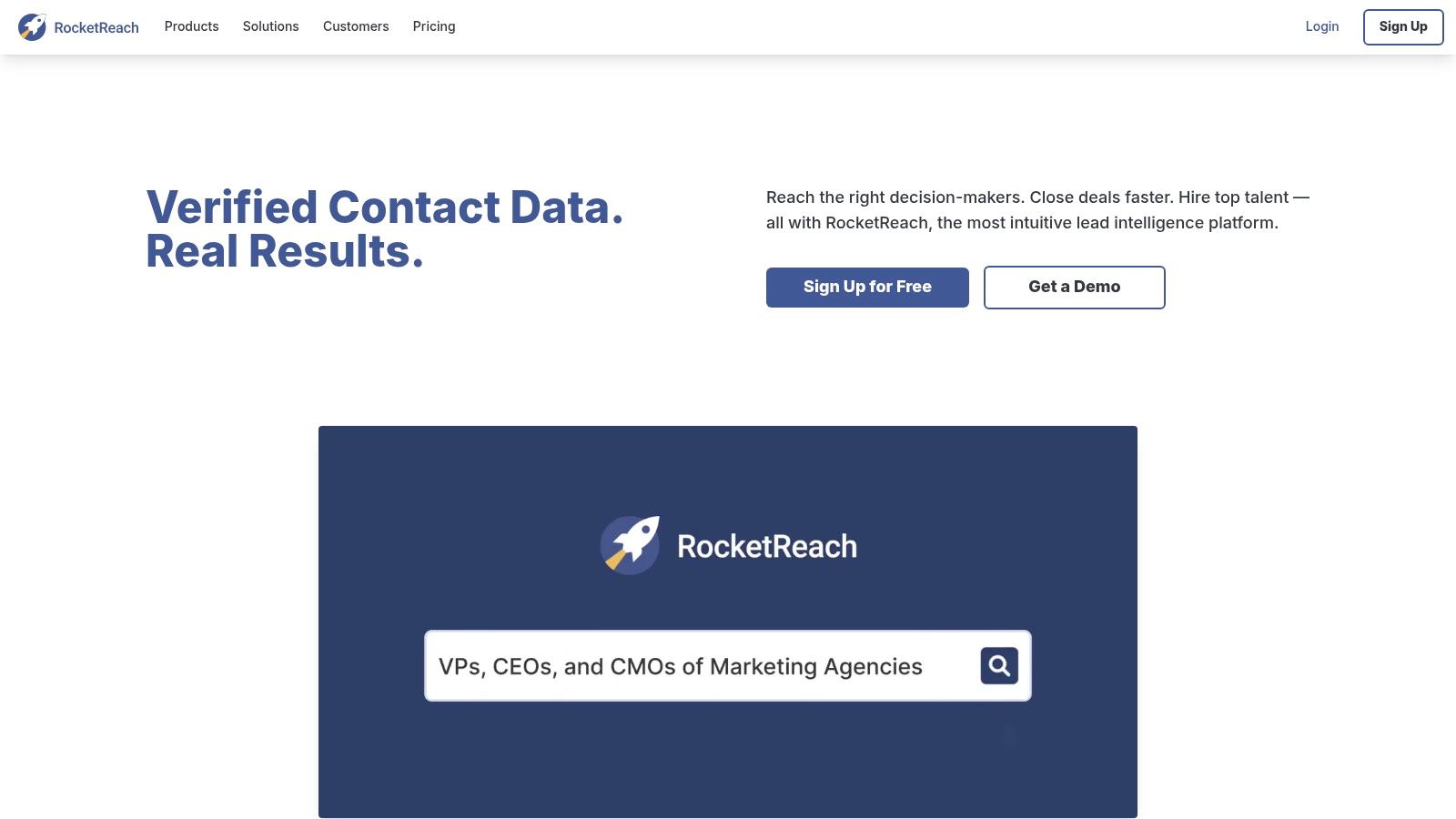
One thing that's really great about RocketReach is its self-serve model. Unlike many platforms that hide pricing behind a "request a demo" button, RocketReach offers clear, granular plans for individuals and teams. This transparency is a huge plus.
During our tests, the Chrome extension proved to be quite effective for rapid email discovery across various industries. It’s one of the fastest ways we’ve found to build a targeted list from scratch. If you’re looking for different capabilities, such as more advanced intent data, consider platforms like GojiberryAI, which offer a more specialized approach.
Key Features & User Experience
- Person & Company Search: Provides access to a large database with filters, org charts, and technographic data to refine your search.
- Bulk Lookups: You can upload a list of names or companies and have RocketReach enrich them with contact details, saving significant manual effort.
- API Access: Higher-tier plans provide API access, enabling custom integrations and automated data retrieval workflows.
- Simple Chrome Extension: The browser extension is the star of the show, enabling one-click contact lookups directly on professional networking sites and company pages.
Pros & Cons
- Pro: The flexible, self-serve pricing plans for both individuals and teams make it very easy to get started without a big commitment.
- Con: Its credit-based system means you have to monitor your usage carefully to avoid running out mid-month. We also found that while email accuracy is generally strong, the availability and accuracy of phone numbers can be inconsistent, especially in niche markets.
8. Seamless.AI
Seamless.AI positions itself as a real-time search engine for B2B contacts. This makes it a powerful high-volume alternative to Sales Navigator for teams that quickly exhaust their contact credits. Its core promise is delivering verified cell phones and direct-dial emails with an AI-assisted engine.
One thing we really loved during our tests was the "use it or lose it" daily credit refresh on their Pro plans. This encourages consistent daily prospecting habits and serves as a game-changer for teams that need a constant flow of fresh leads without hoarding credits.

It is more than just a contact finder; it’s an ecosystem. With optional add-ons for buyer intent data, job change alerts, and data enrichment, it can be tailored to more sophisticated sales motions.
The real-time search, accessed via its Chrome extension, felt snappy, pulling contact information directly from LinkedIn or company websites. However, a key point to remember is that their pricing isn't public. You’ll need to talk to their sales team, which can be a hurdle if you're just trying to compare options quickly.
Key Features & User Experience
- Real-Time Search Engine: The platform’s Chrome extension finds contacts in real time, rather than just pulling from a static database.
- Daily Credit Refresh: A unique model on paid plans that provides a fresh batch of credits each day, promoting active and continuous prospecting.
- Optional Add-Ons: You can enhance the core product with buyer intent data, job change tracking, and automated list-building features.
- Enterprise-Ready: Strong administrative controls are available for managing teams, permissions, and credit allocation, making them ideal for larger organizations.
Pros & Cons
- Pro: The daily credit system is fantastic for high-volume sales development teams that need a predictable and steady lead source.
- Con: Pricing is not transparent and requires a sales consultation. We also found their auto-renewal policies can be strict, so it’s crucial to read your contract and manage subscription terms carefully to avoid surprises.
9. LeadIQ
LeadIQ is a pure-play prospecting tool designed for speed and efficiency. It's a great alternatives Sales Navigator for teams that prioritize rapid list building. It specializes in collecting verified email addresses and mobile numbers, syncing them directly with your primary sales tools or CRM.
Think of it as the ultimate accelerator for your SDRs. Its main strength is its simplicity and how seamlessly it integrates into an existing workflow, primarily through its robust Chrome extension.
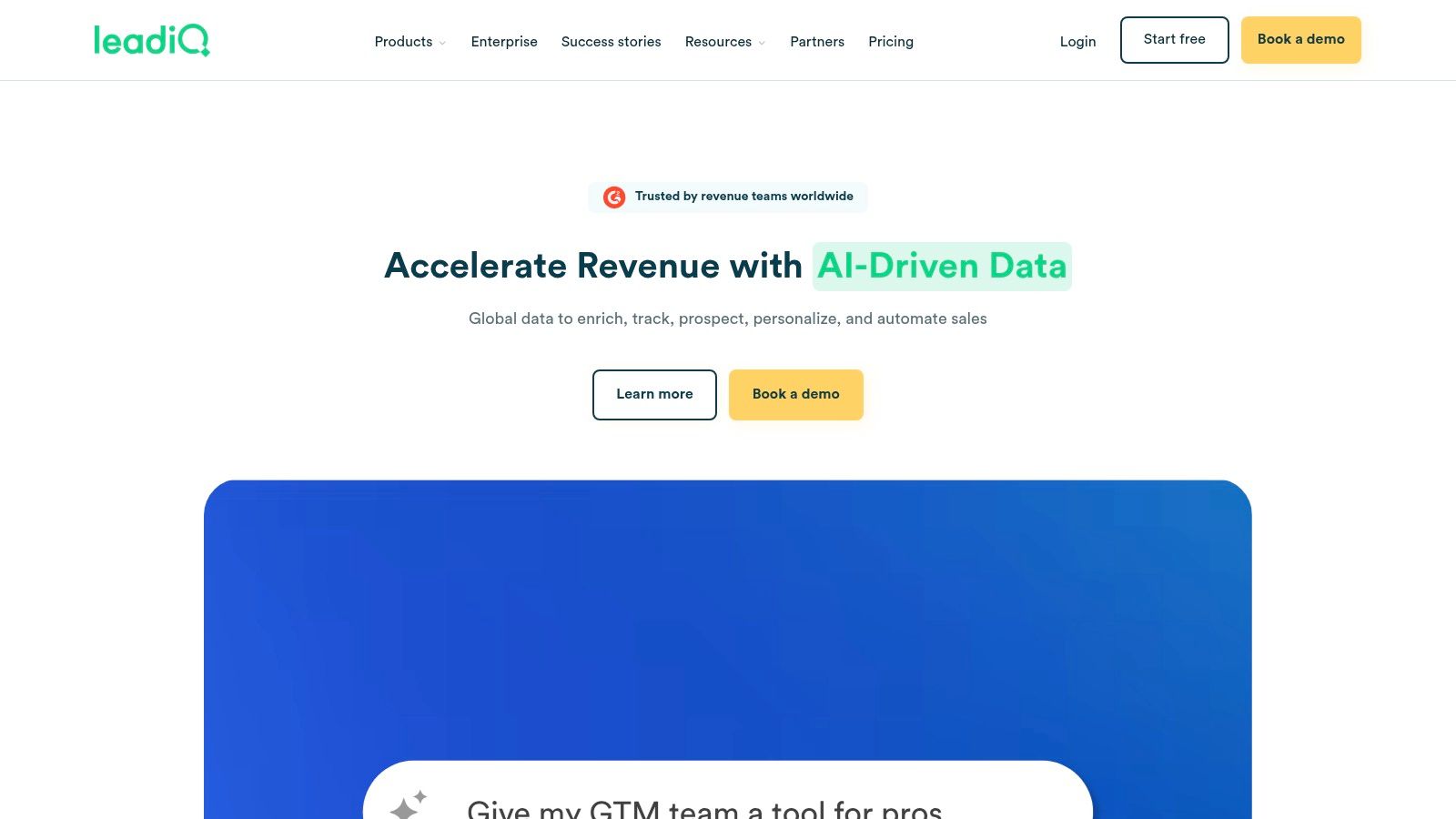
The platform is incredibly clean and easy to deploy across a team with minimal training. You just browse LinkedIn or company websites, click the extension, and capture verified contacts with a single click. The data is then enriched and pushed to your CRM or tools like Outreach or Salesloft, eliminating tedious manual entry.
It doesn’t pretend to be a full engagement platform; it’s a specialized capture tool that does its job exceptionally well, freeing up your reps to focus on selling rather than data entry.
Key Features & User Experience
- Verified Contact Capture: Its core function is to find and verify emails and mobile phone numbers accurately.
- Seamless Chrome Extension: The extension is the main feature, enabling easy prospecting from LinkedIn profiles, Sales Navigator searches, and company websites.
- Direct-to-Workflow Sync: Integrates smoothly with major CRMs (Salesforce, HubSpot) and sales engagement platforms, pushing captured data where it needs to go.
- Transparent Plans: LeadIQ offers a free tier for individuals and clear, affordable paid plans, making it accessible for teams of all sizes.
Pros & Cons
- Pro: The user experience is exceptionally clean, and its focused approach makes it incredibly easy to deploy and adopt.
- Con: It's not a full multi-channel engagement platform, so you'll need separate tools for sequencing and dialing. Higher usage limits require moving up to their Enterprise tier.
10. Snov.io
Snov.io is a strong and affordable alternative to Sales Navigator, offering a complete prospecting tool for teams on a tight budget. It’s an all-in-one toolkit for finding and verifying emails, automating outreach campaigns, and even warming up your email account to improve deliverability.
This makes it a fantastic choice for startups and small businesses that need a robust set of tools without the enterprise price tag. Want to cover your entire top-of-funnel without breaking the bank? Snov.io is a serious contender.
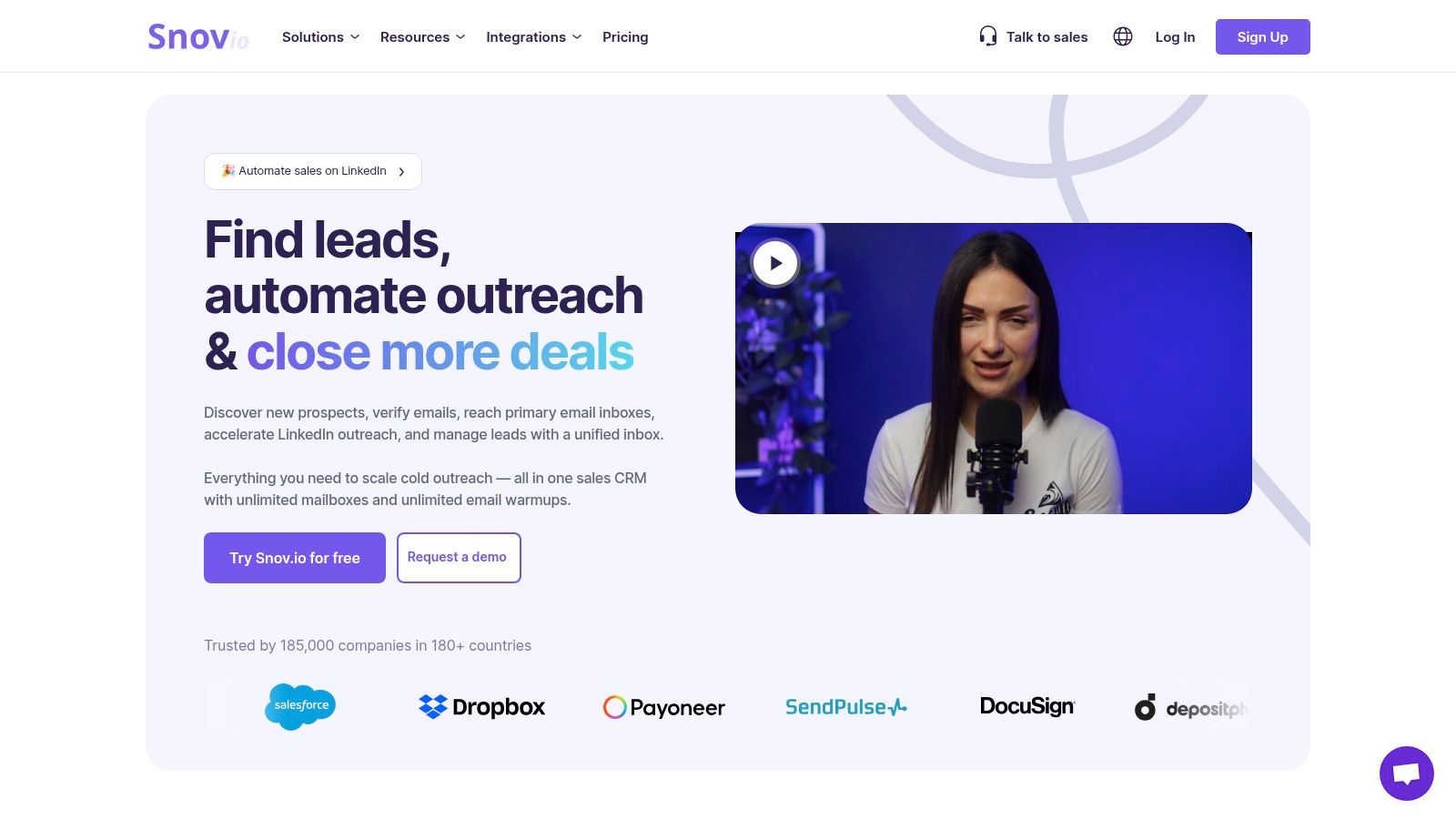
What really caught our attention was the emphasis on email deliverability, which is built directly into the platform. You get tools to warm up your sending address and check email placement, which are often expensive, separate services. This demonstrates a deep understanding of a common prospecting pain point, ensuring your carefully crafted messages actually reach the inbox.
We found their browser extension to be effective for quickly grabbing contacts; however, its LinkedIn automation feature is a paid add-on, which is a key consideration if that's a priority for your workflow.
Key Features & User Experience
- Multichannel Outreach: Create automated drip campaigns that combine email follow-ups and triggered actions, ensuring consistent pipeline engagement.
- Integrated Deliverability Tools: Includes built-in email warm-up and placement checks to maximize your sender reputation and inbox rates.
- Generous Credit System: The platform operates on a credit system for email searches and verifications, offering substantial quotas at competitive prices.
- Broad Integrations: Snov.io connects with major CRMs via its native API and offers extensive automation possibilities through Zapier.
Pros & Cons
- Pro: The built-in deliverability toolkit provides incredible value, helping you avoid the dreaded spam folder.
- Con: The data depth and coverage may not always be able to compete with larger enterprise vendors. We also found that the LinkedIn automation requires a separate paid add-on, which can be a hidden cost if that's a critical feature for you.
11. SalesIntel
SalesIntel enters the scene with a powerful, accuracy-first proposition that makes it a compelling alternative to Sales Navigator for teams tired of dealing with stale data. The main distinction is that its contact information is verified by humans, targeting 95% accuracy for emails and mobile numbers.
For sales teams heavily focused on the North American market, this emphasis on quality over quantity can be a significant time-saver. Think about it, how much time do you waste on bounced emails and wrong numbers? SalesIntel aims to eliminate that headache.

What stood out to us was its unlimited data model. Unlike the credit-based systems of many competitors, most SalesIntel plans allow for unlimited exports and enrichment. This is a significant win for data-intensive operations that require consistent CRM updates without worrying about hitting a cap.
We found their Research-on-Demand service particularly useful, as it allowed us to request specific contacts that were not yet in their database. It felt like having a dedicated research assistant.
Key Features & User Experience
- Human Verification: A team of researchers verifies contact and company data, which significantly boosts confidence in outreach campaigns.
- Unlimited Enrichment & Exports: Core plans remove the friction of credit limits, allowing you to enrich your entire CRM and export data freely.
- Research-on-Demand: If a contact you need isn't in the database, their team will find it for you, typically within a few hours.
- Robust Integrations: It connects directly with major platforms like Salesforce, HubSpot, Marketo, Outreach, and Salesloft.
Pros & Cons
- Pro: The emphasis on human-verified accuracy and the unlimited usage model provides fantastic, predictable value.
- Con: Pricing is quote-based, so you must engage with their sales team to obtain a quote. We also noted that advanced features, such as buying intent data, are often add-on modules that can increase the overall cost.
12. Crunchbase
Crunchbase has long been my secret weapon for account-level intelligence, making it a powerful and distinct alternative to Sales Navigator. Where Sales Nav focuses heavily on people, Crunchbase shines a spotlight on companies, tracking funding rounds, growth signals, and key firmographics.
If your sales strategy is account-based and you need to understand which companies are primed for growth, hiring, or have just received a fresh round of capital, Crunchbase is where you should start your research. It’s perfect for mapping out a market or identifying trigger events that create new sales opportunities.

What makes Crunchbase a go-to for top-of-funnel prospecting is its focus on timing. Getting an alert that a target account just closed a Series B funding round is a gold-plated reason to reach out.
Although it doesn't focus on individual contact data like some other platforms, its Pro plan and contact data add-ons offer a budget-friendly option to merge detailed company insights with useful contact details.
For those seeking diverse capabilities or a more comprehensive approach, exploring other alternative solutions to Sales Navigator can offer the ideal balance for your workflow.
Key Features & User Experience
- Growth Signals & Alerts: Set up alerts for target accounts or entire industries to get notified about funding rounds, acquisitions, and other key market events.
- Robust Search & Filtering: The "Pro Search" utilizes AI to help you find companies based on highly specific criteria, such as industry, location, funding stage, and recent activity.
- API & Marketplace: Higher tiers provide API access and a marketplace with add-ons for tech stack data, patents, and more, enabling deep customization.
- CRM Integration: The Business tier syncs with Salesforce and HubSpot, pushing valuable company data directly into your existing workflows.
Pros & Cons
- Pro: Unmatched for account-level research and identifying market signals. The affordable Pro plan is great for piloting and small teams.
- Con: Direct contact data is a paid add-on and is capped, unlike unlimited platforms. Advanced integrations and higher export limits are locked behind more expensive tiers.
Top 12 Alternatives Sales Navigator Comparison
Your Next Move: From Prospecting to Connecting
We’ve just journeyed through a dozen powerful alternatives to Sales Navigator, from the comprehensive data powerhouse of ZoomInfo to the agile, startup-friendly model of UpLead.
The one thing that should be crystal clear now? The world of sales intelligence is vast, and clinging to a single, expensive platform just because it's the "default" is a costly mistake. I learned that the hard way, pouring thousands into a tool that wasn't optimized for my team's nimble, multi-channel approach.
The biggest takeaway isn't that one tool is definitively "better" than another. The best tool is the one that aligns perfectly with your specific sales motion, team size, budget, and ideal customer profile. Relying on a generic platform is like using a sledgehammer to crack a nut; it might work, but it’s messy, inefficient, and you'll probably crush what you were trying to get.
A Step-by-Step Tutorial on Choosing a Tool For You
So, where do you go from here? Don't get paralyzed by choice. Instead, get strategic. Here's my step-by-step guide to making your next move with confidence.
- Audit Your Current Process (The Brutal Truth): Before you even think about a demo, map out your existing sales workflow. Where are the bottlenecks? Is your email bounce rate sky-high? Are your SDRs spending more time searching than selling? Be honest.
- What to do: Write down the top 3 friction points in your current process.
- What NOT to do: Don't just blame the tool. Acknowledge process gaps. A shiny new tool won't fix a broken strategy.
- Define Your "Must-Haves" vs. "Nice-to-Haves": Create a simple checklist. "Accurate mobile numbers for VPs in tech" is a must-have. "Chrome extension that shows company funding rounds" might be a nice-to-have. This clarity will prevent you from being dazzled by flashy features you'll never use.
- What to do: Match your friction points to features. If your problem is finding warm leads, "intent data" is a must-have. That's where GojiberryAI shines. If data accuracy is the concern, consider Cognism or SalesIntel. Need an all-in-one for a small team? Apollo.io is your jam.
- What NOT to do: Never pick a tool based on the longest feature list. Select it based on the features that address your most significant pain points.
- Run Targeted Pilot Programs (The Showdown): NEVER migrate your whole team at once. My biggest mistake was switching everyone overnight—chaos!
- What to do: Select your top two contenders. Assign two reps to each for a two-week sprint. Have them target the exact same ICP and track results in a shared spreadsheet, including dials made, emails sent, bounce rate, replies received, and meetings booked.
- What NOT to do: Don't just ask "how do you like it?" Let the cold, hard data make the decision. Feelings are fallible; numbers aren't.
From Data Overload to Deals Closed
Ultimately, these tools are just that: tools. They don't close deals—you do. The goal is to find the platform that removes friction and empowers your team to do what they do best. The era of blindly scrolling and blasting out templated messages is over. It's inefficient and, frankly, disrespectful to your prospects.
Your mission now is to transition from generic prospecting to genuine connection. By choosing one of these smart alternatives Sales Navigator, you’re not just buying a software license; you’re investing in a more intelligent, targeted, and human-centric way of selling. It’s time to equip your team with a tool that truly understands and accelerates your unique path to growth. Now, go make it happen. ✨
Ready to see how AI can completely transform your targeting and outreach strategy? If you’re looking for a tool that goes beyond simple contact data to deliver hyper-relevant prospects based on deep buying signals, check out GojiberryAI. It’s the next-generation sales intelligence platform designed to help you connect with the right people at the exact right time. Explore GojiberryAI today and start building a pipeline that actually converts.
Frequently Asked Questions
Why should I even look for an alternative to Sales Navigator? Isn't it the industry standard?
That's a great question, and it's the one I asked myself for years! Sales Navigator is powerful for building lists based on firmographics (such as company size, industry, etc.) and job titles. However, its biggest weakness is that it lacks timing and intent. It tells you who your prospects are, but not when they're ready to make a purchase.
Alternatives like GojiberryAI focus on buying signals (such as job changes or funding rounds) to help you reach out at the perfect moment, dramatically increasing your chances of getting a response. Think of it as the difference between fishing in the entire ocean vs. fishing where you know the fish are biting.
I'm a solo founder with a tiny budget. Which of these tools offers the best value for my money?
I feel this one! When you're starting out, every dollar counts. For pure bang for your buck, Apollo.io is a strong contender, offering a generous free tier and all-in-one functionality. You get a contact database and an email sequencer in one place.
However, if your time is more valuable than your money (which it usually is for founders), investing in a tool like GojiberryAI can yield a higher ROI. It automates the most time-consuming part of sales—finding warm leads—so you can focus on closing deals instead of prospecting.
What is the biggest mistake people make when choosing a new sales tool?
The biggest mistake is choosing a tool based on a demo from a sales representative without conducting your own hands-on pilot. A demo is designed to look perfect. In the real world, you'll hit snags.
My worst experience was adopting a tool that promised amazing CRM integration, only to find out it was buggy and required constant manual fixes. NEVER commit to a contract until at least two of your own reps have used the tool for a real-world, two-week sprint and you've seen the data on their results.
How important is "intent data" really? Is it just another buzzword?
It's not a buzzword; it's a revolution in sales. Traditional prospecting is like knocking on every door in a neighborhood. Intent-based prospecting is like knocking on the doors with "For Sale" signs. Intent data tools track online signals, like a company researching your competitors or hiring for a key role, that indicate they are actively looking to solve a problem you can fix.
Ignoring intent data in 2025 is like choosing to navigate with a paper map instead of a GPS. You might get there eventually, but you're working way harder than you need to.
More High-Intent Leads = Your New Growth Engine.
Start Now and Get New High Intent Leads DeliveredStraight to Slack or Your Inbox.








